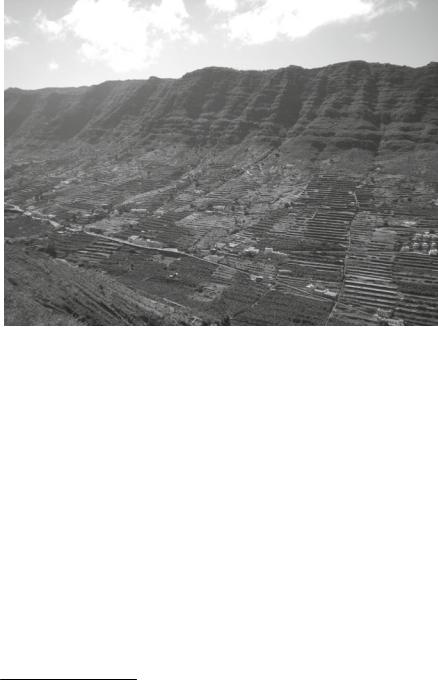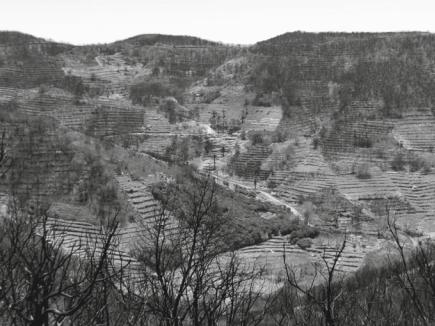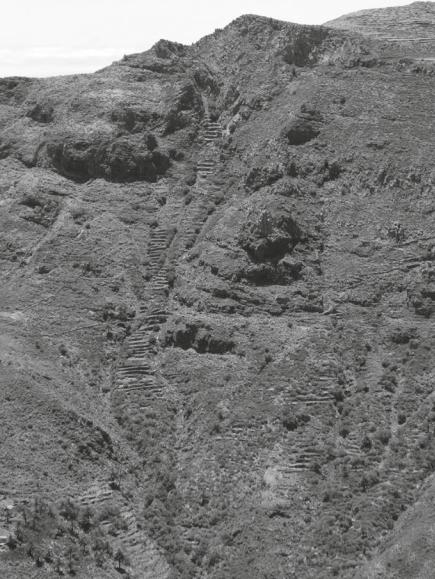
- •Series Editor’s Preface
- •Contents
- •Contributors
- •1 Introduction
- •References
- •2.1 Methodological Introduction
- •2.2 Geographical Background
- •2.3 The Compelling History of Viticulture Terracing
- •2.4 How Water Made Wine
- •2.5 An Apparent Exception: The Wines of the Alps
- •2.6 Convergent Legacies
- •2.7 Conclusions
- •References
- •3.1 The State of the Art: A Growing Interest in the Last 20 Years
- •3.2 An Initial Survey on Extent, Distribution, and Land Use: The MAPTER Project
- •3.3.2 Quality Turn: Local, Artisanal, Different
- •3.3.4 Sociability to Tame Verticality
- •3.3.5 Landscape as a Theater: Aesthetic and Educational Values
- •References
- •4 Slovenian Terraced Landscapes
- •4.1 Introduction
- •4.2 Terraced Landscape Research in Slovenia
- •4.3 State of Terraced Landscapes in Slovenia
- •4.4 Integration of Terraced Landscapes into Spatial Planning and Cultural Heritage
- •4.5 Conclusion
- •Bibliography
- •Sources
- •5.1 Introduction
- •5.3 The Model of the High Valleys of the Southern Massif Central, the Southern Alps, Castagniccia and the Pyrenees Orientals: Small Terraced Areas Associated with Immense Spaces of Extensive Agriculture
- •5.6 What is the Reality of Terraced Agriculture in France in 2017?
- •References
- •6.1 Introduction
- •6.2 Looking Back, Looking Forward
- •6.2.4 New Technologies
- •6.2.5 Policy Needs
- •6.3 Conclusions
- •References
- •7.1 Introduction
- •7.2 Study Area
- •7.3 Methods
- •7.4 Characterization of the Terraces of La Gomera
- •7.4.1 Environmental Factors (Altitude, Slope, Lithology and Landforms)
- •7.4.2 Human Factors (Land Occupation and Protected Nature Areas)
- •7.5 Conclusions
- •References
- •8.1 Geographical Survey About Terraced Landscapes in Peru
- •8.2 Methodology
- •8.3 Threats to Terraced Landscapes in Peru
- •8.4 The Terrace Landscape Debate
- •8.5 Conclusions
- •References
- •9.1 Introduction
- •9.2 Australia
- •9.3 Survival Creativity and Dry Stones
- •9.4 Early 1800s Settlement
- •9.4.2 Gold Mines Walhalla West Gippsland Victoria
- •9.4.3 Goonawarra Vineyard Terraces Sunbury Victoria
- •9.6 Garden Walls Contemporary Terraces
- •9.7 Preservation and Regulations
- •9.8 Art, Craft, Survival and Creativity
- •Appendix 9.1
- •References
- •10 Agricultural Terraces in Mexico
- •10.1 Introduction
- •10.2 Traditional Agricultural Systems
- •10.3 The Agricultural Terraces
- •10.4 Terrace Distribution
- •10.4.1 Terraces in Tlaxcala
- •10.5 Terraces in the Basin of Mexico
- •10.6 Terraces in the Toluca Valley
- •10.7 Terraces in Oaxaca
- •10.8 Terraces in the Mayan Area
- •10.9 Conclusions
- •References
- •11.1 Introduction
- •11.2 Materials and Methods
- •11.2.1 Traditional Cartographic and Photo Analysis
- •11.2.2 Orthophoto
- •11.2.3 WMS and Geobrowser
- •11.2.4 LiDAR Survey
- •11.2.5 UAV Survey
- •11.3 Result and Discussion
- •11.4 Conclusion
- •References
- •12.1 Introduction
- •12.2 Case Study
- •12.2.1 Liguria: A Natural Laboratory for the Analysis of a Terraced Landscape
- •12.2.2 Land Abandonment and Landslides Occurrences
- •12.3 Terraced Landscape Management
- •12.3.1 Monitoring
- •12.3.2 Landscape Agronomic Approach
- •12.3.3 Maintenance
- •12.4 Final Remarks
- •References
- •13 Health, Seeds, Diversity and Terraces
- •13.1 Nutrition and Diseases
- •13.2 Climate Change and Health
- •13.3 Can We Have Both Cheap and Healthy Food?
- •13.4 Where the Seed Comes from?
- •13.5 The Case of Yemen
- •13.7 Conclusions
- •References
- •14.1 Introduction
- •14.2 Components and Features of the Satoyama and the Hani Terrace Landscape
- •14.4 Ecosystem Services of the Satoyama and the Hani Terrace Landscape
- •14.5 Challenges in the Satoyama and the Hani Terrace Landscape
- •References
- •15 Terraced Lands: From Put in Place to Put in Memory
- •15.2 Terraces, Landscapes, Societies
- •15.3 Country Planning: Lifestyles
- •15.4 What Is Important? The System
- •References
- •16.1 Introduction
- •16.2 Case Study: The Traditional Cultural Landscape of Olive Groves in Trevi (Italy)
- •16.2.1 Historical Overview of the Study Area
- •16.2.3 Structural and Technical Data of Olive Groves in the Municipality of Trevi
- •16.3 Materials and Methods
- •16.3.2 Participatory Planning Process
- •16.4 Results and Discussion
- •16.5 Conclusions
- •References
- •17.1 Towards a Circular Paradigm for the Regeneration of Terraced Landscapes
- •17.1.1 Circular Economy and Circularization of Processes
- •17.1.2 The Landscape Systemic Approach
- •17.1.3 The Complex Social Value of Cultural Terraced Landscape as Common Good
- •17.2 Evaluation Tools
- •17.2.1 Multidimensional Impacts of Land Abandonment in Terraced Landscapes
- •17.2.3 Economic Valuation Methods of ES
- •17.3 Some Economic Instruments
- •17.3.1 Applicability and Impact of Subsidy Policies in Terraced Landscapes
- •17.3.3 Payments for Ecosystem Services Promoting Sustainable Farming Practices
- •17.3.4 Pay for Action and Pay for Result Mechanisms
- •17.4 Conclusions and Discussion
- •References
- •18.1 Introduction
- •18.2 Tourism and Landscape: A Brief Theoretical Staging
- •18.3 Tourism Development in Terraced Landscapes: Attractions and Expectations
- •18.3.1 General Trends and Main Issues
- •18.3.2 The Demand Side
- •18.3.3 The Supply Side
- •18.3.4 Our Approach
- •18.4 Tourism and Local Agricultural System
- •18.6 Concluding Remarks
- •References
- •19 Innovative Practices and Strategic Planning on Terraced Landscapes with a View to Building New Alpine Communities
- •19.1 Focusing on Practices
- •19.2 Terraces: A Resource for Building Community Awareness in the Alps
- •19.3 The Alto Canavese Case Study (Piedmont, Italy)
- •19.3.1 A Territory that Looks to a Future Based on Terraced Landscapes
- •19.3.2 The Community’s First Steps: The Practices that Enhance Terraces
- •19.3.3 The Role of Two Projects
- •19.3.3.1 The Strategic Plan
- •References
- •20 Planning, Policies and Governance for Terraced Landscape: A General View
- •20.1 Three Landscapes
- •20.2 Crisis and Opportunity
- •20.4 Planning, Policy and Governance Guidelines
- •Annex
- •Foreword
- •References
- •21.1 About Policies: Why Current Ones Do not Work?
- •21.2 What Landscape Observatories Are?
- •References
- •Index

7 Terraced Landscapes in the Canary Islands: La Gomera … |
111 |
Fig. 7.10 Hermigua ravine. Photo M. C. Iglesias López
7.4.2Human Factors (Land Occupation and Protected Nature Areas)
Through an analysis of current land cover, it is possible to study the evolution of the terraced landscapes. Almost half of the terraced landscapes have been colonized by shrubby and herbaceous vegetation (48.6%), mainly by climax shrubs (Neochamaeleo pulverulentae-Euphorbietum balsamiferae, Euphorbietum berthelotii-canariensis, etc.) or natural secondary shrubs (Table 7.3). In the terraced areas that remain in cultivation today, the most notable crops are orchards (13.8%), wine grapes (8.1%) for local consumption and bananas for exportation (4.2%).
Furthermore, forests have colonized 12% of the terraced area. Evergreen forests (laurel forest and Myrica faya-Erica arborea) have colonized 8.3% of the terraced area,7 thermophilous forests 2.7%, while reforestation with foreign species represents 0.1% (Fig. 7.11).
7No terrain surface data re-colonized by evergreen forest affected by the fire of 2012 were available for this study.
112 |
|
L. E. Romero Martín et al. |
||
Table 7.3 Distribution of terraces by land cover |
|
|
|
|
|
|
|
|
|
Group |
Class |
|
Area |
% |
|
|
|
(ha) |
|
Scrub and herbaceous |
Coastal scrub |
|
1622.4 |
19.7 |
vegetation |
Secondary scrub |
|
1390.8 |
16.9 |
|
|
|||
|
Pasture |
|
983.7 |
11.9 |
|
“Escobón” shrubland |
|
4.9 |
0.1 |
Subtotal |
|
|
4001.8 |
48.6 |
Agricultural |
Herbaceous crops |
|
1138.1 |
13.8 |
|
Abandoned crops |
|
701.4 |
8.5 |
|
Vineyard |
|
667.9 |
8.1 |
|
Banana |
|
349.8 |
4.2 |
|
Greenhouse |
|
16.7 |
0.2 |
|
Tropical fruit trees |
|
13.0 |
0.2 |
|
Citrus fruit trees |
|
3.4 |
0.0 |
|
Ocean temperate fruit trees |
|
2.0 |
0.0 |
Subtotal |
|
|
2892.2 |
35.1 |
Forests and reforestation |
Laurel forest |
|
363.6 |
4.4 |
|
Myrica faya-Erica arborea |
|
321.2 |
3.9 |
|
Thermophilous forests |
|
226.2 |
2.7 |
|
Ravine vegetation |
|
49.0 |
0.6 |
|
Pinus canariensis |
|
13.7 |
0.2 |
|
Pinus halepensis |
|
7.6 |
0.1 |
|
Pinus radiata |
|
4.1 |
0.0 |
|
Eucaliptus sp. |
|
0.4 |
0.0 |
Subtotal |
|
|
985.9 |
12.0 |
BARE SOIL |
Extraction of materials, works |
|
107.6 |
1.3 |
|
Sparse vegetation |
|
71.5 |
0.9 |
|
Dumping site, graveyard |
|
2.8 |
0.0 |
|
Beach, dunes, and sandy area |
|
1.3 |
0.0 |
Subtotal |
|
|
183.2 |
2.2 |
Urbanizations and |
Dense housing developments |
|
81.0 |
1.0 |
infrastructures |
Urbanization along roads |
|
46.7 |
0.6 |
|
|
|||
|
Airports and infrastructures |
|
13.8 |
0.2 |
|
Industrial complexes |
|
6.1 |
0.1 |
|
Dispersed urbanization |
|
5.3 |
0.1 |
|
Sports, recreation, health, and education |
3.9 |
0.0 |
|
|
facilities |
|
|
|
|
Military installations |
|
2.2 |
0.0 |
Subtotal |
|
|
158.9 |
2.0 |
Water |
Dam |
|
8.9 |
0.1 |
|
Pond |
|
2.2 |
0.0 |
Subtotal |
|
|
11.1 |
0.1 |
Total |
|
|
8233.1 |
100.0 |

7 Terraced Landscapes in the Canary Islands: La Gomera … |
113 |
Fig. 7.11 Effects of the 2012 fire in Guadiana ravine. Photo J. C. Hernández Navarro
Terraces are present in 16 of the 17 Protected Nature Areas existing on the island, but only represent 8.7% (712.7 ha) of total terraced area. One of the goals of these Protected Nature Areas is the conservation of humanized landscapes. They include Valle Gran Rey Rural Park, Orone Protected Landscape (Fig. 7.12), and Barranco del Cabrito Natural Monument (Table 7.4).
Of the 25 terrestrial Special Areas of Conservation (SAC) existing in the island, 24 contain terraces, representing 20.4% (1683.3 ha) of total terraced surface area (Table 7.5). Most of the terraces are located in SAC Teselinde—Cabecera de Vallehermoso, Montaña del Cepo, Cuenca de Benchijigua—Guarimiar, Orone, Barranco del Charco Hondo, Valle Alto de Valle Gran Rey, Barranco del Cabrito, and Barranco del Cedro y Liria.

114 |
L. E. Romero Martín et al. |
Fig. 7.12 Orone Protected Landscape. Photo J. C. Hernández Navarro
7 Terraced Landscapes in the Canary Islands: La Gomera … |
115 |
|||
Table 7.4 Distribution of terraces in Protected Nature Areas |
|
|
||
|
|
|
|
|
Protected Nature Areas |
Area (ha) |
|
Terraces of the island (%) |
|
Valle de Gran Rey Rural Park |
259.3 |
3.1 |
||
Orone Protected Landscape |
163.9 |
2.0 |
||
Barranco del Cabrito Natural Monument |
118.8 |
1.4 |
||
Majona Natural Park |
44.7 |
0.5 |
||
Lomo del Carretón Natural Monument |
42.2 |
0.5 |
||
La Fortaleza Natural Monument |
16.6 |
0.2 |
||
Garajonay National Park |
14.9 |
0.2 |
||
La Caldera Natural Monument |
13.8 |
0.2 |
||
Roque Cano Natural Monument |
11.7 |
0.1 |
||
Puntallana Special Nature Reserve |
11.6 |
0.1 |
||
Charco del Conde Site of Scientific Interest |
5.7 |
0.1 |
||
Roque Blanco Natural Monument |
4.3 |
0.1 |
||
Acantilados de Alajeró Site of Scientific Interest |
4.3 |
0.1 |
||
Benchijigua Integral Nature Reserve |
0.6 |
0.0 |
||
Los Órganos Natural Monument |
0.2 |
0.0 |
||
Charco de Cieno Site of Scientific Interest |
0.0 |
0.0 |
||
Total |
712.7 |
8.7 |
||
Table 7.5 Distribution of terraces in Special Areas of Conservation |
||||
|
|
|
|
|
Special Areas of Conservation (SAC) |
|
Area (ha) |
|
Terraces of the island (%) |
Teselinde–Cabecera de Vallehermoso |
|
350.2 |
|
4.3 |
(ES7020097) |
|
|
|
|
Montaña del Cepo (ES7020098) |
|
200.2 |
|
2.4 |
Cuenca de Benchijigua–Guarimiar (ES7020107) |
|
187.4 |
|
2.3 |
Orone (ES7020039) |
|
164.0 |
|
2.0 |
Barranco del Charco Hondo (ES7020102) |
|
160.2 |
|
1.9 |
Valle Alto de Valle Gran Rey (ES7020104) |
|
131.4 |
|
1.6 |
Barranco del Cabrito (ES7020035) |
|
118.8 |
|
1.4 |
Barranco del Cedro y Liria (ES7020109) |
|
106.3 |
|
1.3 |
Majona (ES7020030) |
|
44.7 |
|
0.5 |
Laderas de Enchereda (ES7020101) |
|
43.3 |
|
0.5 |
Lomo del Carretón (ES7020037) |
|
42.2 |
|
0.5 |
Taguluche (ES7020108) |
|
37.7 |
|
0.5 |
Garajonay (ES0000044) |
|
18.9 |
|
0.2 |
La Fortaleza (ES7020034) |
|
16.6 |
|
0.2 |
Cabecera Barranco de Aguajilva (ES7020106) |
|
12.5 |
|
0.2 |
Roque Cano (ES7020032) |
|
11.7 |
|
0.1 |
Puntallana (ES7020029) |
|
11.6 |
|
0.1 |
(continued)
